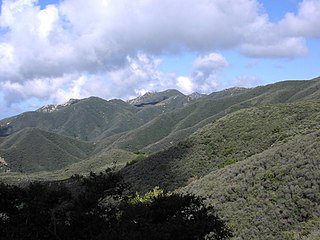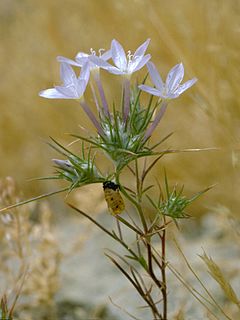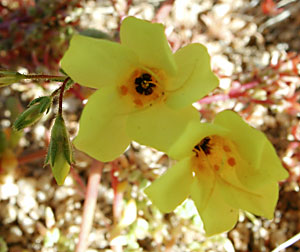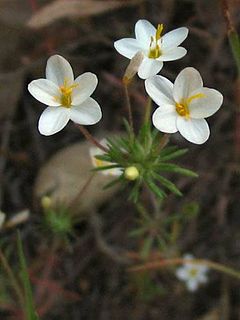| Saltugilia | |
|---|---|
 | |
| Saltugilia splendens ssp. grantii | |
| Scientific classification | |
| Kingdom: | Plantae |
| Clade: | Angiosperms |
| Clade: | Eudicots |
| Clade: | Asterids |
| Order: | Ericales |
| Family: | Polemoniaceae |
| Genus: | Saltugilia (V.E. Grant) L.A. Johnson |
| Species | |
4, see text | |
| Synonyms | |
Gilia sect. Saltugilia | |
| Wikimedia Commons has media related to Saltugilia . |
Saltugilia is a genus of flowering plants in the phlox family, Polemoniaceae. They are known commonly as woodland gilias. [1] There are four species. Two are endemic to California in the United States, and the distributions of the other two extend into Baja California in Mexico.
A genus is a taxonomic rank used in the biological classification of living and fossil organisms, as well as viruses, in biology. In the hierarchy of biological classification, genus comes above species and below family. In binomial nomenclature, the genus name forms the first part of the binomial species name for each species within the genus.

The Polemoniaceae are a family of about 25 genera with 270-400 species of annual and perennial plants, native to the Northern Hemisphere and South America, with the center of diversity in western North America, especially in California.

Endemism is the ecological state of a species being unique to a defined geographic location, such as an island, nation, country or other defined zone, or habitat type; organisms that are indigenous to a place are not endemic to it if they are also found elsewhere. The extreme opposite of endemism is cosmopolitan distribution. An alternative term for a species that is endemic is precinctive, which applies to species that are restricted to a defined geographical area.
Contents
This genus was erected in the year 2000 to segregate three species from the genus Gilia on the basis of phylogenetic evidence. Analysis of DNA was used in the formation of the new taxon, and studies of other characteristics of the plants, such as morphological, palynological, and ecological traits, were considered. Saltugilia was a section of genus Gilia. These three species were classified in the new genus Saltugilia, [1] and the fourth was newly described to science in 2001. [2]

Gilia is a genus of between 25 and 50 species of flowering plants in the family Polemoniaceae, native to temperate and tropical regions of the Americas, from the western United States south to northern Chile, where they occur mainly in desert or semi-desert habitats.

In biology, phylogenetics is the study of the evolutionary history and relationships among individuals or groups of organisms. These relationships are discovered through phylogenetic inference methods that evaluate observed heritable traits, such as DNA sequences or morphology under a model of evolution of these traits. The result of these analyses is a phylogeny – a diagrammatic hypothesis about the history of the evolutionary relationships of a group of organisms. The tips of a phylogenetic tree can be living organisms or fossils, and represent the "end", or the present, in an evolutionary lineage. Phylogenetic analyses have become central to understanding biodiversity, evolution, ecology, and genomes.

Deoxyribonucleic acid is a molecule composed of two chains that coil around each other to form a double helix carrying the genetic instructions used in the growth, development, functioning, and reproduction of all known living organisms and many viruses. DNA and ribonucleic acid (RNA) are nucleic acids; alongside proteins, lipids and complex carbohydrates (polysaccharides), nucleic acids are one of the four major types of macromolecules that are essential for all known forms of life.













